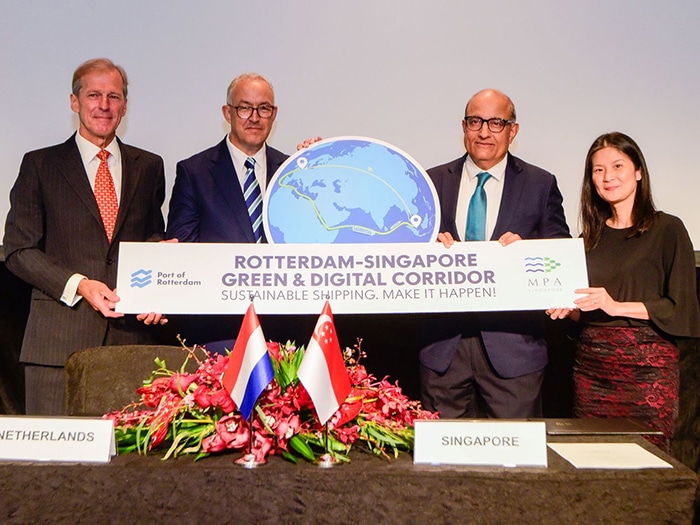
Singapore and Rotterdam to create the world’s longest green and digital shipping corridor
Written by Nick Blenkey
L to R: Allard Castelein (CEO Port of Rotterdam Authority), Ahmed Aboutaleb (Mayor of Rotterdam), S. Iswaran (Minister of Transport and Trade Relations Singapore) and Quah Ley Hoon (CEO Maritime and Port Authority Singapore).
The concept of “green corridors” as a means of accelerating shipping decarbonization first made the news at COP26 in Glasgow. Now, the Maritime and Port Authority of Singapore (MPA) and the Port of Rotterdam Authority have signed a memorandum of understanding (MoU) to establish the world’s longest green and digital corridor to enable low and zero carbon shipping.
Signed by Quah Ley Hoon, Chief Executive of MPA, and Mr Allard Castelein, CEO of the Port of Rotterdam Authority at the Marina Bay Sands Convention Centre on the sidelines of the biennial World Cities Summit, the MoU will bring together stakeholders across the supply chain to see the first sustainable vessels sailing on the route by 2027.
Singapore and Rotterdam are among the largest bunkering ports in the world, making them vital links on the Asian-European shipping lanes. While international shipping currently uses largely marine gas oil (MGO) and low-sulfur fuel oil, sustainable alternatives such as biofuels, including biogases, are increasingly being made available. Other alternatives such as synthetic methane, hydrogen, and hydrogen-based fuels including ammonia and methanol are in various stages of R&D for future trials and deployment.
Each alternative fuel has its own challenges relating to costs, availability, safety, and restrictions in range due to lower energy density compared to fossil fuels. To tackle these challenges, the two port authorities agreed to bring together a broad coalition of shippers, fuel suppliers and other companies to collectively work on potential solutions.
DIGITAL TRADE LANE
Beyond alternative fuels, the green corridors MoU also aims to optimize maritime efficiency, safety, and the transparent flow of goods by creating a digital trade lane where relevant data, electronic documentation and standards are shared. This will facilitate the seamless movement of vessels and cargo, and optimize just-in-time arrival of vessels from port to port.
The port authorities will work with the Global Center for Maritime Decarbonization and the Mærsk Mc-Kinney Møller Center for Zero-Carbon Shipping, as well as other industry partners across the supply chain, including BP, CMA CGM, Digital Container Shipping Association, Maersk, MSC, Ocean Network Express, PSA International, and Shell. The aim is enable the green corridor project to raise investment confidence, attract green financing, and kickstart joint bunkering pilot projects and trials for digitalization and the use of low- and zero carbon fuels along the route.




